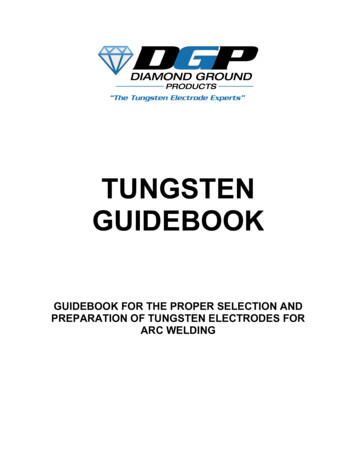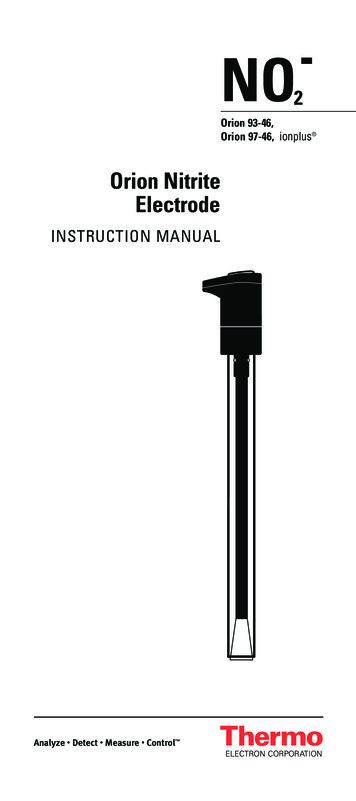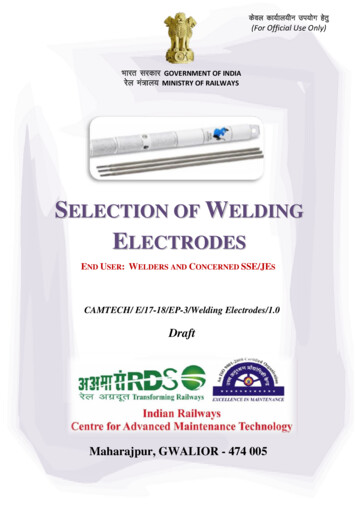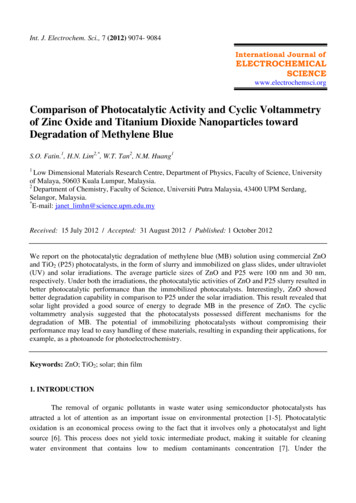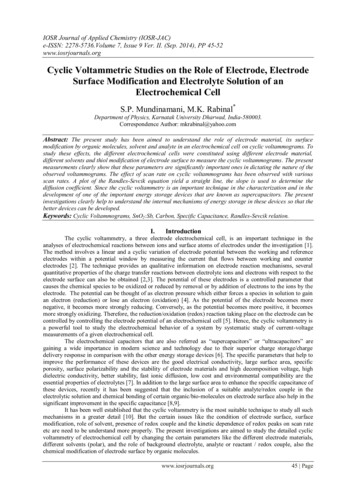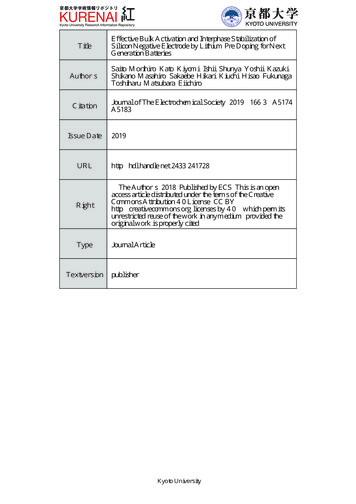
Transcription
TitleEffective Bulk Activation and Interphase Stabilization ofSilicon Negative Electrode by Lithium Pre-Doping for NextGeneration BatteriesAuthor(s)Saito, Morihiro; Kato, Kiyomi; Ishii, Shunya; Yoshii, Kazuki;Shikano, Masahiro; Sakaebe, Hikari; Kiuchi, Hisao; Fukunaga,Toshiharu; Matsubara, EiichiroCitationJournal of The Electrochemical Society (2019), 166(3): A5174A5183Issue Date2019URLhttp://hdl.handle.net/2433/241728Right The Author(s) 2018. Published by ECS. This is an openaccess article distributed under the terms of the CreativeCommons Attribution 4.0 License (CC BY,http://creativecommons.org/licenses/by/4.0/), which permitsunrestricted reuse of the work in any medium, provided theoriginal work is properly cited.TypeJournal ArticleTextversionpublisherKyoto University
A5174Journal of The Electrochemical Society, 166 (3) A5174-A5183 (2019)JES FOCUS ISSUE OF SELECTED PAPERS FROM IMLB 2018Effective Bulk Activation and Interphase Stabilization of SiliconNegative Electrode by Lithium Pre-Doping for Next-GenerationBatteriesMorihiro Saito, 1, ,z Kiyomi Kato,1 Shunya Ishii,1 Kazuki Yoshii, 2 Masahiro Shikano,Hikari Sakaebe,2, Hisao Kiuchi,3 Toshiharu Fukunaga,3 and Eiichiro Matsubara41 Department2of Applied Chemistry, Tokyo University of Agriculture and Technology, Koganei-shi, Tokyo 184-8588,Japan2 ResearchInstitute of Electrochemical Energy, Department of Energy and Environment, National Institute of AdvancedIndustrial Science and Technology (AIST), Ikeda, Osaka 563-8577, Japan3 Office of Society-Academia Collaboration for Innovation, Kyoto University, Kyoto 611-0011, Japan4 Department of Materials Science and Engineering, Kyoto University, Kyoto 606-8501, JapanTo clarify the effects of Li pre-doping of a Si negative electrode for potential application in next-generation energy storage systems,such as Li–S and Li–O2 batteries, such electrodes were prepared by direct Li pre-doping using Li metal foil and by electrochemicalpre-doping at 700 mA g 1 (Si) using a two-electrode cell. These were evaluated by comparing their charge/discharge properties,mainly by half-cell operation at a limited capacity of 2000 mAh g 1 (Si). Fluoroethylene carbonate (FEC) was added to form a stablesolid electrolyte interphase film on the surface of the electrodes. The depth and homogeneity of Li pre-doping were improved byusing the direct Li pre-doping method and by FEC addition, respectively. The rapid Li pre-doping of this method caused cracks andpulverization of the Si nanoparticles and promoted deep Li alloying by decreasing the Li diffusion distance. The tough homogeneoussolid electrolyte interphase film derived from FEC suppressed electrolyte decomposition and enabled a fast Li alloying/de-alloyingreaction. Addition of 10 mass% FEC to the half-cell electrolyte repaired damage to the interphase film caused by the large volumechange of Si nanoparticles and improved cyclability to exceed 230 cycles. The Author(s) 2018. Published by ECS. This is an open access article distributed under the terms of the Creative CommonsAttribution 4.0 License (CC BY, http://creativecommons.org/licenses/by/4.0/), which permits unrestricted reuse of the work in anymedium, provided the original work is properly cited. [DOI: 10.1149/2.0271903jes]Manuscript submitted October 22, 2018; revised manuscript received December 6, 2018. Published December 18, 2018. This paperis part of the JES Focus Issue of Selected Papers from IMLB 2018.In recent years, new-generation energy storage systems, such asLi–S and Li–O2 batteries, have attracted much attention because of theenergy density limitations of Li-ion batteries.1 These new-generationbatteries have much higher energy densities, exceeding 500 Wh kg 1 .These high-energy storage systems do not have the Li as the positiveelectrode and need to use Li metal as the negative electrode (NE),the theoretical capacity of which is 3860 mAh g 1 . However, a Limetal NE risks short-circuiting by Li dendrite deposition and has poorrate capability because of its small surface area due to the flatness ofthe electrode, which typically takes the form of a foil or thin film.In contrast, Si is a good NE candidate for these batteries becauseof its high theoretical capacity (ca. 4200 mAh g 1 )2,3 and relativesuppression of Li dendrite deposition by the charge/discharge processdue to the Li alloying/de-alloying reactions. In addition, Si activematerials usually use nano-materials, such as nanoparticles (NPs),4–11nano-wires,12–17 and nano-flakes.18,19 This not only suppresses fadingof the capacity due to cracking and pulverization of Si active materialsbut also improves the cyclability and rate capability of Si NEs byincreasing the reaction area.To apply Si NEs to next-generation batteries, it is necessary topre-dope them with Li, i.e., Li alloying. The development of easierand more convenient methods of pre-doping Li into Si NEs and detailed investigation of their resulting charge/discharge properties isimportant. Recent research on Li pre-doping into graphite and hardcarbon NEs has been undertaken in study of Li-ion capacitors,20,21but there are very few reports of Li pre-doping of Si NEs.22,23 Wealso previously prepared Li pre-doped Si NEs and tried to assembleLi-ion capacitors,24 demonstrating stable operation to 800 cycles,25where their operating range was around 500 mAh g 1 (Si). However,the influence of Li pre-doping on the electrochemical properties andtheir mechanism are still not sufficiently clarified especially at a largeroperating range for next-generation batteries. Electrochemical Society Member.zE-mail: mosaito@cc.tuat.ac.jpIn this study, we prepared Li pre-doped Si NEs by direct Li predoping (DP) using Li metal foil and by electrochemical pre-doping(EP) using a two-electrode cell, both without and with fluoroethylenecarbonate (FEC) as an additive to form a stable solid electrolyte interphase (SEI) film on the Si NE surface. The electrochemical data for thefour Li pre-doped Si NEs were compared, mainly by half-cell operation at a limited capacity of 2000 mAh g 1 (Si). Their charge/dischargeproperties and cyclability were investigated in detail from the viewpoints of Si bulk activation and interphase stabilization by proper SEIformation on the electrode surface. The charge/discharge propertiesof Li pre-doped Si NE using an FEC additive in both Li pre-dopingand half-cell electrolytes were also evaluated.ExperimentalPreparation of nanosilicon-coated negative electrodes.—Si NPs(Nanostructured & Amorphous Materials, Inc.; average particle size:30–50 nm) were used as the Si active material. A slurry was preparedby mixing 80 mass% Si NPs, 5 mass% Ketjen Black (KB; Lion,EC600JD) as a conductive agent, and 15 mass% polyimide binder(I.S.T Corporation, Dream bond; solid ratio: ca. 46%) with N-methyl2-pyrrolidone (NMP; Wako) as a solvent. The slurry was coated onCu foil (Fukuda Metal Foil & Powder Co., Ltd.; thickness: 35 μm)as a current collector, dried at 60 C for 1 h, cured at 200 C for 12 hunder vacuum, and then cut into circles (ϕ 16 mm; i.e., the NE areawas ca. 2 cm2 ). The thickness of the Si NE coating was ca. 6 μm,which corresponded to a loading mass of 0.45–0.57 mg (Si) cm 2 asan active material. Li pre-doping and cell assembly were performedin an Ar-filled dry box (Miwa, MDB-1BK-NT1).Preparation of lithium pre-doped silicon negative electrodes.—For Li pre-doping, two methods were used. In the DP method,24,25the Si NE was contacted with Li metal foil (Honjo Metal, thickness:0.05 mm) and then immersed in 1.0 M LiPF6 dissolved in ethylene carbonate and dimethyl carbonate (EC DMC, 1:1 by volume;Tomiyama Pure Chemical Industries, Ltd., battery grade) at roomDownloaded on 2019-06-11 to IP 130.54.110.32 address. Redistribution subject to ECS terms of use (see ecsdl.org/site/terms use) unless CC License in place (see abstract).
Journal of The Electrochemical Society, 166 (3) A5174-A5183 (2019)A5175Figure 1. Charge/discharge curves of lithium pre-doped silicon negative electrode half-cells prepared using the (a, b) electrochemical pre-doping (EP) and (c, d,e) direct pre-doping (DP) methods.temperature for 3 h. The EP method used a Si NE half-cell [Si NE Li metal foil (Honjo Metal, thickness: 0.5 mm)] that was operatedin constant-current mode at a rate of C/6 (700 mA g 1 ) for the SiNPs from the open circuit potential to 0.02 V vs. Li/Li using a battery test system (Hokuto Denko, HJ1001SM8). In some experiments,10 mass% FEC (Kishida Chemicals, battery grade) was added to theelectrolyte prior to Li pre-doping. A vacuum pressure impregnationtreatment was conducted prior to Li pre-doping.In this study, the Li pre-doped Si NEs by the DP and EP methodswith the use and non-use of 10 mass% FEC additive were defined as“DP without FEC”, “DP with FEC”, “EP without FEC” and “EP withFEC”, respectively.Assembly of half-cells and electrochemical evaluation.—Cointype half-cells were constructed, using the Li pre-doped Si NEs asthe working electrode, a separator (TEF4030, Nippon Kodoshi), andLi metal (Honjo metal, thickness: 0.5 mm) as the counter electrode,in the same dry box used for the Li pre-doping. As with the Li predoping process, 1.0 M LiPF6 /EC DMC (1:1 by volume) without andwith 10 mass% FEC was used as the electrolyte. Charge/discharge (Lialloying/de-alloying) tests were carried out in constant-current modeat C/6 (700 mA g 1 (Si)) between 1.5 and 0.02 V using a batterytest system (Hokuto Denko, HJ1001SM8). The charge/discharge ca-pacity was limited to 2000 mAh g 1 (Si). Cyclic voltammetry (CV)was performed at a potential scanning rate of 0.10 mV s 1 between1.50 and 0.02 V using an electrochemical measurement system (BioLogic Science Instruments, VSP). All measurements were conductedat 30 C.For the “DP with FEC” electrode, we also subjected thecharge/discharge test using 10 mass% FEC-added electrolyte to investigate the effect of FEC in the electrolyte by comparing with the“EP with FEC”. The data was defined as “DP & cell electrolyte withFEC”.Characterization of lithium pre-doped silicon negativeelectrodes.—Morphology changes of the Si NEs before and afterLi pre-doping were observed by scanning electron microscopy (SEM;JEOL, JSM-6510LA) using an accelerating voltage of 15 kV. Thevolume change of the Si NPs was evaluated by scanning probe microscopy (SPM; SHIMADZU, SPM-9700HT) in an Ar-filled glovebox (Glovebox Japan Inc., GBJF100). The SPM imaging was conducted in phase mode, using a Si cantilever (NanoWorld PointprobeNCH probes). The bulk crystal phases of the Si NPs were identifiedby X-ray diffraction (XRD; Rigaku, SmartLab) using Cu Kα radiation(45 kV, 200 mA). The chemical components of SEI films formed onthe surfaces of the Si NEs were analyzed by X-ray photoelectronDownloaded on 2019-06-11 to IP 130.54.110.32 address. Redistribution subject to ECS terms of use (see ecsdl.org/site/terms use) unless CC License in place (see abstract).
A5176Journal of The Electrochemical Society, 166 (3) A5174-A5183 (2019)Figure 2. Cyclability of lithium pre-doped silicon negative electrode half-cells prepared using the (a) electrochemical pre-doping (EP) and (b) direct pre-doping(DP) methods.spectroscopy (XPS; ULVAC-PHI, INC., PHI 5000 VersaProbe)and hard X-ray photoelectron spectroscopy (HAXPES; SPring8/BL28XU). Before all characterizations, the Si NEs were washedtwice with 3 mL dimethyl carbonate (DMC; Kishida Chemicals, battery grade) to remove residual electrolyte around the samples anddried for 1 h. Transfer vessels were used to avoid moisture and air exposure. For the HAXPES analysis, charge correction was conductedusing the LiF peak and the strength was normalized relative to thetotal area of the HAXPES peak for each element.Results and DiscussionCharge/discharge properties of lithium pre-doped silicon negative electrode half-cells at capacity limitation of 2000 mAh g 1(Si).—Figure 1 shows the discharge/charge curves of Li pre-dopedSi NE half-cells prepared by the EP and DP methods without andwith 10 mass% FEC. For the EP method, the first charging (Li alloying) curve decreased rapidly at around 0.10 V and maintained alow potential, indicating that the crystalline phase of Si was destroyedand an amorphous Lix Siy phase formed.26 As a result, the dischargecurve exhibited a slope from 0.20 V, i.e. de-alloying from the amorphous Lix Siy phase. Cyclability was improved by the addition of FECto the electrolyte. The limiting capacity of 2000 mAh g 1 (Si) wasmaintained to around 100 cycles, as shown in Fig. 2.In contrast, the first discharge curve for electrodes prepared by theDP method started from ca. 0.4 V and was relatively flat, indicatingthe occurrence of de-alloying by phase transfer from the Li15 Si4 crystalline phase to the Lix Siy amorphous phase.26 The Li15 Si4 crystallinephase was formed by deep Li alloying above 3580 mhA g 1 . TheDP method therefore enabled more rapid Li pre-doping than the EPmethod.The presence of FEC improved the cyclability up to about 50 cycles; however, capacity fading was confirmed thereafter; however, capacity fading was significantly suppressed by also adding 10 mass%FEC into the electrolyte for the DP-treated Si NE half-cell (Fig. 2).The high capacity of 2000 mAh g 1 (Si) was maintained for over230 cycles. This meant that FEC in the electrolyte repaired the SEIfilm that was damaged by expansion and shrinkage of Li–Si alloy NPsduring the charge and discharge cycles, respectively.Effects of method of lithium pre-doping and fluoroethylene carbonate additive.—Figure 3 shows the dQ/dV curves of Si NE half-cellsprepared by Li pre-doping using the EP and DP methods without andwith 10 mass% FEC additive. In the case of the EP method, phasetransfer of Si from crystalline to amorphous phases was clearly definedby the sharp peaks at 0.06 V. After the first Li alloying, the de-alloyingprocess started at around 0.20 V; however, additional noise currentsappeared in the discharge curves at around 0.31 V, which indicatedelectrolyte decomposition. The current remained after 10 cycles forthe half-cell without FEC addition. After adding FEC to the electrolyte(Fig. 3b), the noise current was significantly reduced and reversibilityof the charge/discharge curves improved.This behavior was confirmed for the DP-treated Si NE half-cells.Li pre-doped Si NE prepared by the DP method without FEC additiveexhibited a similar noise current during the first discharge process at0.32 V and during the following cycles at 0.27 V; however, the currentdue to electrolyte decomposition was clearly diminished by addingFEC to the electrolyte, thereby improving cyclability. Further additionof FEC to the half-cell electrolyte slightly increased the noise current.This indicated that the Si NPs were stabilized by growth of SEI filmderived from the additional FEC additive in half-cell during initialcycles. In addition, all DP-treated Si NEs exhibited current peaksduring the first discharge at around 0.4 V, which corresponded to dealloying from Li15 Si4 to a Lix Siy amorphous phase. This implied thatthe DP method enabled much deeper Li pre-doping to be achievedthan the EP method. As a result, the DP-treated Si NEs exhibitedlarger discharge/charge (de-alloying/alloying) currents including thefollowing cycles. The FEC addition both at Li pre-doping and inhalf-cell electrolyte enhanced the effect and provided stability for thesmooth de-alloying/alloying reaction.Homogeneity and depth of lithium pre-doping.—From the electrochemical data for the Li pre-doped Si NEs, in particular that obtained by the DP method with addition of FEC, it was evident thatLi pre-doping effectively influenced both the surface by formationof intact SEI films and the bulk structure of Si NPs. Figure 4 showsSEM images and insets of selected photographs of Li pre-doped SiNEs, both of which confirm the morphology changes. In the absenceof FEC, Li pre-doping was inhomogeneous, i.e., part of the Si NEsurface did not change to black (indicating more Li alloying) andthe color remained gray (indicating less Li alloying) for both SEMand photographic images. In the gray region, many cracks causedby mechanical stress were observed, indicating inhomogeneity of Lialloying. For the EP method, the presence of a gas pool caused byelectrolyte decomposition between the Si NE and separator after theLi pre-doping was confirmed: the gas prevented Li supply to the SiNPs.In contrast, Si NEs that used FEC in both the DP and EP methodsclearly exhibited homogeneous Li alloying. This implied that FECenabled homogeneous and coherent SEI films to form on the Si NEsurface and suppressed some electrolyte decomposition that generatedsome of the gases. In particular, for the DP method, the black color ofthe Si NE images was deeper and aggregated Si NPs became larger,indicating deeper Li pre-doping. This is in good agreement with thetrends of the charge/discharge properties, which indicated surfacestabilization and sufficient bulk activation of Si NEs.Figure 5 shows SPM images of Li pre-doped Si NEs. For thoseprepared using the EP method, the Si NPs gradually grew and theirparticle size increased with FEC addition. In contrast, the Si particle size was reduced by preparation using the DP method, implyingDownloaded on 2019-06-11 to IP 130.54.110.32 address. Redistribution subject to ECS terms of use (see ecsdl.org/site/terms use) unless CC License in place (see abstract).
Journal of The Electrochemical Society, 166 (3) A5174-A5183 (2019)A5177Figure 3. dQ/dV curves of lithium pre-doped silicon negative electrode half-cells prepared usingthe electrochemical pre-doping (EP) and direct predoping (DP) methods. (f), (g), (h), (i), and (j) arethe expanded data toward y-axis of (a), (b), (c), (d),and (e), respectively.Downloaded on 2019-06-11 to IP 130.54.110.32 address. Redistribution subject to ECS terms of use (see ecsdl.org/site/terms use) unless CC License in place (see abstract).
A5178Journal of The Electrochemical Society, 166 (3) A5174-A5183 (2019)cracking and pulverization of Si NPs by the rapid volume changecaused by Li alloying. This also accelerated Li pre-doping andachieved deep homogeneous Li alloying.Figure 4. Scanning electron micrographs of lithium pre-doped silicon negative electrodes prepared using the electrochemical pre-doping (EP) and directpre-doping (DP) methods. (c), (d), (g), and (h) are the magnified images of (a),(b), (e), and (f), respectively.Lithium pre-doping rate and content.—Figure 6a shows the firstcharging curves of Li pre-doped Si NE half-cells prepared by the EPmethod. The charge capacities were 2233 mAh g 1 and 3021 mAh g 1without and with 10 mass% FEC, respectively. Although charge capacities included the irreversible capacities due to the electrolyte andFEC decomposition, they did not reach either the theoretical capacity(ca. 4200 mAh g 1 ) or the capacity for Li15 Si4 (3580 mAh g 1 ), eventhough charging was increased by the FEC addition. From the firstcharging curve at around 0.60 V, the extra irreversible capacity due toFEC decomposition was 100 mAh g 1 ; therefore, the Li pre-dopedcontent in the Si NE was considered to increase by addition of FECto the electrolyte.We also prepared two Si NE half-cells using the DP method withoutand with 10 mass% FEC and subjected these to external short-circuits.The currents obtained owing to the Li pre-doping are shown in Fig. 6b.The charge capacities were 3338 mAh g 1 and 3885 mAh g 1 withoutand with FEC, respectively. Both charge capacities were higher thanthose for electrodes prepared using the EP method, and the effect ofFEC was confirmed. In addition, the DP method enabled rapid Li predoping and the charge capacities obtained after ca. 30 min exceededthose of electrodes prepared by the EP method. The DP method wastherefore an effective way to achieve deep Li pre-doping in a shorttime. This was in good agreement with the decrease in Si particle sizethat occurred by cracking and pulverization due to the rapid volumechange for the DP method. In particular, when adding FEC, the Li predoping rate was enhanced and the SEM observations (Fig. 4) showedthat homogeneity also improved by formation of a proper SEI film onthe Si NE surface.Figure 7 shows XRD patterns of Li pre-doped Si NEs preparedusing the two methods. For the EP method, the XRD peaks attributedto the Si crystalline phase at 28 and 47 remained, especially onnon-addition of FEC. For the DP-treated Si NEs, these peaks becameFigure 5. Scanning probe microscopy images of lithium pre-doped silicon negative electrodes prepared using the electrochemical pre-doping (EP) and directpre-doping (DP) methods.Downloaded on 2019-06-11 to IP 130.54.110.32 address. Redistribution subject to ECS terms of use (see ecsdl.org/site/terms use) unless CC License in place (see abstract).
Journal of The Electrochemical Society, 166 (3) A5174-A5183 (2019)A5179Figure 6. Charge curves and estimated Li contents for lithium pre-doping into silicon negative electrodes prepared using the electrochemical pre-doping (EP) anddirect pre-doping (DP) methods. The detail of change in capacity is summarized Table S1.quite small and those attributed to Li15 Si4 appeared at 23 , 26 , and39 , indicating deep Li pre-doping exceeding 3580 mAh g 1 .26 Theeffect of FEC was also confirmed: peaks due to the crystalline phaseof Si were completely diminished by preparation using the DP methodwith 10 mass% FEC.Effects of direct pre-doping method and fluoroethylene carbonate addition on Li alloying/de-alloying reaction.—From the aboveresults, it was evident that the DP method effectively increased the predoped Li content of all Si NPs by cracking and pulverization owingto rapid Li alloying. This increased their utilization ratio and enableda fast Li alloying/de-alloying reaction. This effect was reflected bythe reversibility of the charge/discharge reactions and dQ/dV curves.In summary, the DP method activated nano-crystalline Si-coated NE;however, these electrochemical data were limited to the applied capacity of 2000 mAh g 1 (Si).To more clearly determine the effects of this method and the presence of FEC on the electrochemical properties, CV curves were collected (Fig. 8). Initial enhancement of charge/discharge capacity wasconfirmed both without and with FEC additive, i.e., the activation effect was attributed to use of the DP method itself. In addition, curvesgenerated in the absence of FEC exhibited a large and wide oxidation current owing to electrolyte decomposition from around 0.6 V,which continued until the following charging process, i.e., until formation of a new SEI film from 0.4 V. This was probably causedby the large volume change of Si NPs from Li15 Si4 crystalline toLix Siy amorphous phases during the first discharge. The SEI filmFigure 7. X-ray diffraction patterns of lithium pre-doped silicon negativeelectrodes prepared using the electrochemical pre-doping (EP) and direct predoping (DP) methods.that formed on the Si NE surface was not sufficiently stable againstlarge volume changes. When using FEC, electrolyte decompositionwas significantly suppressed by the stable SEI film and subsequentcharge/discharge curves also improved. This indicated that the SEIfilm formed when using FEC was more stable and resistant to thelarge volume change of the Si NPs. This was more clearly observedby a further addition of 10 mass% FEC to the half-cell, which indicated that the extra FEC repaired the damage caused to the SEI filmby the large volume changes during the charge/discharge cycles.Homogeneity and chemical composition of solid electrolyte interphase films.—Figure 9 shows elasticity images of SEI films onthe Li pre-doped Si NEs. In the absence of FEC, the elasticity distribution had two peaks; however, for both preparation methods, onlyone peak appeared after addition of FEC. This indicated that the SEIfilm became more homogeneous when derived from FEC and repairedproperly in response to the smooth and fast Li alloying/de-alloying reaction for subsequent cycles. Viscoelastic images (Fig. S1) exhibitedthe same trend and were in good agreement with the high elasticityimages, suggesting the formation of an organic polymer-based SEIfilm.Differences in components of the SEI films derived from the twomethods were investigated by XPS and HAXPES analyses. Figure 10shows the XPS spectra: there was no significant difference betweenthe two methods. Similar trends were confirmed for both methods withrespect to FEC, i.e., SEI films that formed with FEC addition includedan increase in C compounds, such as a more flexible polymeric layerand Li2 CO3 , that were derived from its decomposition. This is in goodagreement with results reported by Veith et al.27 In contrast, the XPSspectra due to LiF became smaller than those for electrodes preparedin the absence of FEC. This implied that DP-treated Si NE formed anorganic polymer-rich condensed SEI film on the Si NP surfaces overa LiF-rich layer, i.e., the deeper Li pre-doping lowered the potentialof the Si NPs, which enhanced FEC decomposition to form a stablelayered SEI film, which made it tougher and more flexible. The surfaceof the SEI film formed in the absence of FEC was LiF-rich, indicatingpoor coverage of LiF by an organic polymer layer. The SEI filmprobably easily exfoliated from the Si NP surfaces due to the largevolume change during the charge/discharge cycles. From this point ofview, the DP method has an advantage over the EP method because ofthe lower potential of Li pre-doping: the C 1s peak due to the organicpolymer layer increased and the F 1s peak due to LiF decreased whencompared with those of the EP method. Use of the DP method istherefore considered to give a tougher and more flexible SEI film.Figure 11 shows HAXPES data for the Li pre-doped Si NEs. TheDP method and FEC addition were found to effectively destroy the Sicrystalline phase and convert it to an amorphous phase. In addition,the DP-treated Si NEs exhibited a SiOx Fy phase28,29 on the Si NPs.This indicated that rapid and strong Li pre-doping enabled surfacefluorination of the Si NPs. DP-treated Si NEs are suggested to beDownloaded on 2019-06-11 to IP 130.54.110.32 address. Redistribution subject to ECS terms of use (see ecsdl.org/site/terms use) unless CC License in place (see abstract).
A5180Journal of The Electrochemical Society, 166 (3) A5174-A5183 (2019)Figure 8. Cyclic voltammograms of lithium pre-doped silicon negative electrodes prepared by the direct pre-doping (DP) method without and with the additionof fluoroethylene carbonate (FEC).Figure 9. Elasticity images of lithium pre-doped silicon negative electrodes prepared by the electrochemical pre-doping (EP) and direct pre-doping (DP) methods.Downloaded on 2019-06-11 to IP 130.54.110.32 address. Redistribution subject to ECS terms of use (see ecsdl.org/site/terms use) unless CC License in place (see abstract).
Journal of The Electrochemical Society, 166 (3) A5174-A5183 (2019)A5181Figure 10. X-ray photoelectron spectra of lithium pre-doped silicon negative electrodes prepared using the electrochemical pre-doping (EP) and direct pre-doping(DP) methods.protected by triple-layered SEI films on the Si NP surfaces, i.e., aninorganic layer consisting of SiOx Fy and Lix SiOy , a LiF-rich layer,and a tough, flexible organic polymer layer.Mechanism of silicon interphase stabilization by direct predoping method.—Figure 12 shows schematic models of the Li predoped Si NEs prepared by the two methods without and with FEC.For the EP method without FEC, the initially formed SEI film was nothomogeneous or tough, which caused the capacity to fade by continuous electrolyte decomposition during subsequent charge/dischargecycling; however, FEC addition changed the chemical compositionand homogeneity of the SEI film and increased the Li content in theSi NEs.When using the DP method with FEC, the effects were maintainedand deeper Li pre-doping was achieved. This increased the organicpolymer layer on the LiF-rich layer in the SEI film and partiallyfluorinated the surface of the Si NPs. The resulting three-layeredstructure gave excellent toughness and flexibility against the volumechange of Si NPs.Combination of the DP method and FEC addition thereforeachieved bulk activation and stabilized the interphase of the Si NPs.FEC addition was effective in improving the cyclability of Si NEs;however, for DP-treated Si NEs, the volume change between theLi15 Si4 and Lix Siy amorphous phases was severe, which caused damage to the SEI film. Further FEC addition into the half-cell electrolytewas useful to repair the weaker and damaged points to maintain goodcyclability.Downloaded on 2019-06-11 to IP 130.54.110.32 address. Redistribution subject to ECS terms of use (see ecsdl.org/site/terms use) unless CC License in place (see abstract).
A5182Journal of The Electrochemical Society, 166 (3) A5174-A5183 (2019)addition enabled cyclability to be improved to exceed 230 cycles atthe capacity limitation of 2000 mAh g 1 (Si).The key points from this study are as follows: i) use of the DPmethod, compared with the EP method, enabled deeper Li pre-dopingby pulverization of Si nanoparticles owing to rapid Li alloying; ii)FEC addition in the DP method improved the chemical compositionand homogeneity of the SEI film, which improved its toughness andflexibility by increasing the organic polymer layer on the LiF-richlayer in the film; iii) further addition of FEC to the half-cell electrolyterepaired damaged parts of SEI film attributed to the large volumechange of Si NE.Per the above results, after Li pre-doping, the Si NE should beoperated below at least 3580 mAh g 1 , corresponding to the formationof the Li15 Si4 crystalline phase; however, this specific capacity is stillattractive as an alternative to the Li metal NE (ca. 3800 mAh g 1 ). TheLi metal NE is generally considered for use at half dissolution andhalf deposition, corresponding to ca. 1900 mAh g 1 (Li); th
Morihiro Saito, 1, ,z Kiyomi Kato, 1Shunya Ishii, Kazuki Yoshii, 2 Masahiro Shikano, 2 Hikari Sakaebe, 2, Hisao Kiuchi, 3 Toshiharu Fukunaga, 3 and Eiichiro Matsubara 4 1 Department of Applied Chemistry, Tokyo University of Agriculture and Technology, Koganei-shi, Tokyo 184-8588,
